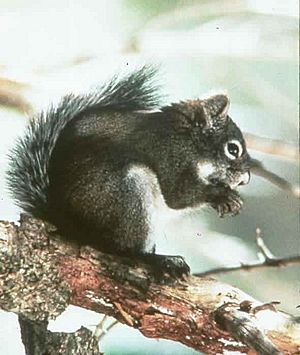Mount Graham red squirrel facts for kids
Quick facts for kids Mount Graham red squirrel |
|
|---|---|
 |
|
| Conservation status | |
| Scientific classification |
|
| Kingdom: | Animalia |
| Phylum: | Chordata |
| Class: | Mammalia |
| Order: | Rodentia |
| Family: | Sciuridae |
| Genus: | Tamiasciurus |
| Species: | |
| Subspecies: |
T. h. grahamensis
|
| Trinomial name | |
| Tamiasciurus hudsonicus grahamensis (J. A. Allen, 1894)
|
|
The Mount Graham red squirrel (Tamiasciurus hudsonicus grahamensis) is a special type of American red squirrel. It lives only in the Pinaleño Mountains in Arizona. This squirrel is smaller than other red squirrels. It also does not have a white-edged tail like many of its relatives. It mostly eats different kinds of seeds, pinecones, and dried mushrooms. It acts much like other squirrels in its family. This squirrel is currently an endangered animal.
Contents
What Does the Mount Graham Red Squirrel Look Like?
Size and Appearance
The Mount Graham red squirrel is a very small animal. It usually weighs about 8 ounces (230 g). Its body is about 8 inches (20 cm) long. Its tail adds another 6 inches (15 cm) to its length.
Unlike many other red squirrels, this one does not have a white edge on its tail. Both male and female squirrels look very similar. They are typically grayish-brown. They also have rusty yellow or orange marks on their backs.
Seasonal Changes
In the winter, these squirrels grow extra fur on their ears. This fur makes their ears look tufted. In the summer, you can see a black line along the side of their body. The squirrel's skull is rounded. Its teeth are low-crowned.
How Does the Mount Graham Red Squirrel Behave?
Mount Graham red squirrels act much like other American red squirrels. They are active during the day. They do not hibernate in the winter. Instead, they stay active, especially during the middle of the day.
Their main foods are different kinds of seeds. They also eat pinecones and dried mushrooms.
Where Does the Mount Graham Red Squirrel Live?
Historically, the Mount Graham red squirrel lived in a large area. This area was about 11,750 acres (47.6 km2) in size. It included spruce-fir and mixed-conifer forests. These forests were found at higher elevations in the Pinaleño Mountains.
Recent studies show they are now found more often in the ecotone zone. This is a special area where two different types of habitats meet. When squirrels choose a place to build a nest, they look for cool, moist spots. These spots must also have lots of food nearby.
Natural events have caused problems for the squirrels. Drought (very dry weather) and forest fires have hurt their homes. Insect outbreaks have also damaged their spruce-fir habitat.
Why Is the Mount Graham Red Squirrel Endangered?
Rediscovery and Protection
People once thought the Mount Graham red squirrel was extinct in the 1950s. But it was "rediscovered" in the 1970s. After it was found again, people suggested it needed protection. They wanted it listed as a threatened or endangered animal. This was under the Endangered Species Act in 1982.
On May 21, 1986, it was officially recommended as endangered. Then, on June 3, 1987, it was officially listed as an endangered species.
Challenges to Survival
The Mount Graham International Observatory was built in the squirrel's habitat. This caused some debate. The observatory must now watch the area around it. This helps to see if its presence harms the squirrel population.
Losing their home is a big problem for these squirrels. This happens for many reasons. Some are natural, like fires. Others are caused by people. In 1988, the U.S. Fish and Wildlife Service made most of this area a special refuge. You need a special permit to enter this protected area.
On June 7, 2017, a lightning strike started a fire. This fire was a serious threat. It might have led to the extinction of this squirrel.
Ongoing Efforts
In September 2019, the U.S. Fish and Wildlife Service agreed to review the squirrel's status. They wanted to see if it needed even more protection. A group asked for this review. They believe the observatory and other buildings should be removed. This is part of a process under the Endangered Species Act.


